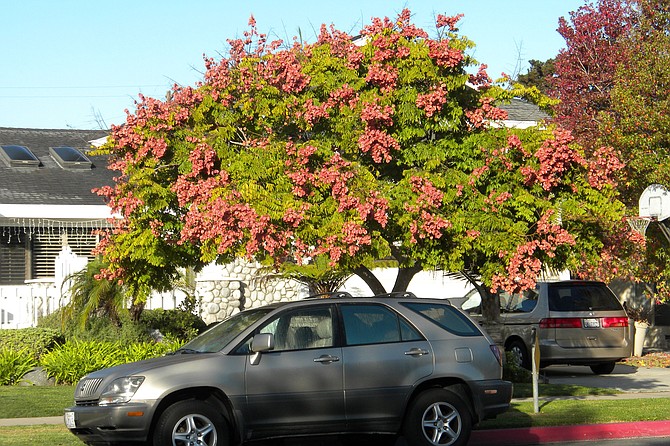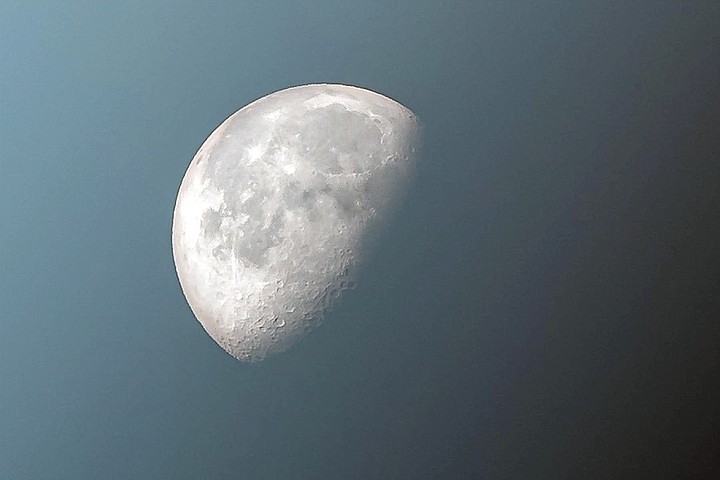 Facebook
Facebook
 X
X
 Instagram
Instagram
 TikTok
TikTok
 Youtube
Youtube

Chinese Flame Trees all over the San Diego region are displaying colorful clusters of orange, reddish, or salmon-pink seed pods. Good specimens line the south end of Balboa Drive in Balboa Park, and Lake Murray Boulevard through San Diego’s San Carlos district. Most of the remainder of San Diego’s ornamental trees will continue to remain drab until November, the onset of “autumn” botanically.
You don’t have photometric-quality eyes, but if you did, you might notice that earthshine on the Moon has gotten just a trace dimmer on average in recent years. This is due to a slow change in Earth’s average reflectivity (albedo) over some 20 years due to changing cloudiness trends. The earthshine fade that P. R. Goode and colleagues measured across two decades from Big Bear Solar Observatory is tiny; it amounts to Earth absorbing an additional 0.5 watt per square meter of incoming sunlight on average. But they say this change matches measurements made by other methods and is “climatologically significant.”

Did you know that October is aurora season? Your chance of catching a display of the Northern Lights is greater now than average around the year, for reasons having to do with the tilt of Earth’s magnetic axis with respect to the incoming solar wind and the shape of Earth’s magnetosphere. This month the magnetosphere’s northern “throat”is well aimed to swallow charged particles from the Sun and steer them down toward the world’s north polar region. Sometimes a gust of particles widens the throat to include lands farther south. The mid-hours of the night are the likeliest time, and of course you want the Moon to have set by then. Keep an eye to the low north.
The above comes from the Outdoors listings in the Reader compiled by Jerry Schad, author of Afoot & Afield in San Diego County. Schad died in 2011. Planet information from SkyandTelescope.org.


Chinese Flame Trees all over the San Diego region are displaying colorful clusters of orange, reddish, or salmon-pink seed pods. Good specimens line the south end of Balboa Drive in Balboa Park, and Lake Murray Boulevard through San Diego’s San Carlos district. Most of the remainder of San Diego’s ornamental trees will continue to remain drab until November, the onset of “autumn” botanically.
You don’t have photometric-quality eyes, but if you did, you might notice that earthshine on the Moon has gotten just a trace dimmer on average in recent years. This is due to a slow change in Earth’s average reflectivity (albedo) over some 20 years due to changing cloudiness trends. The earthshine fade that P. R. Goode and colleagues measured across two decades from Big Bear Solar Observatory is tiny; it amounts to Earth absorbing an additional 0.5 watt per square meter of incoming sunlight on average. But they say this change matches measurements made by other methods and is “climatologically significant.”

Did you know that October is aurora season? Your chance of catching a display of the Northern Lights is greater now than average around the year, for reasons having to do with the tilt of Earth’s magnetic axis with respect to the incoming solar wind and the shape of Earth’s magnetosphere. This month the magnetosphere’s northern “throat”is well aimed to swallow charged particles from the Sun and steer them down toward the world’s north polar region. Sometimes a gust of particles widens the throat to include lands farther south. The mid-hours of the night are the likeliest time, and of course you want the Moon to have set by then. Keep an eye to the low north.
The above comes from the Outdoors listings in the Reader compiled by Jerry Schad, author of Afoot & Afield in San Diego County. Schad died in 2011. Planet information from SkyandTelescope.org.
Comments